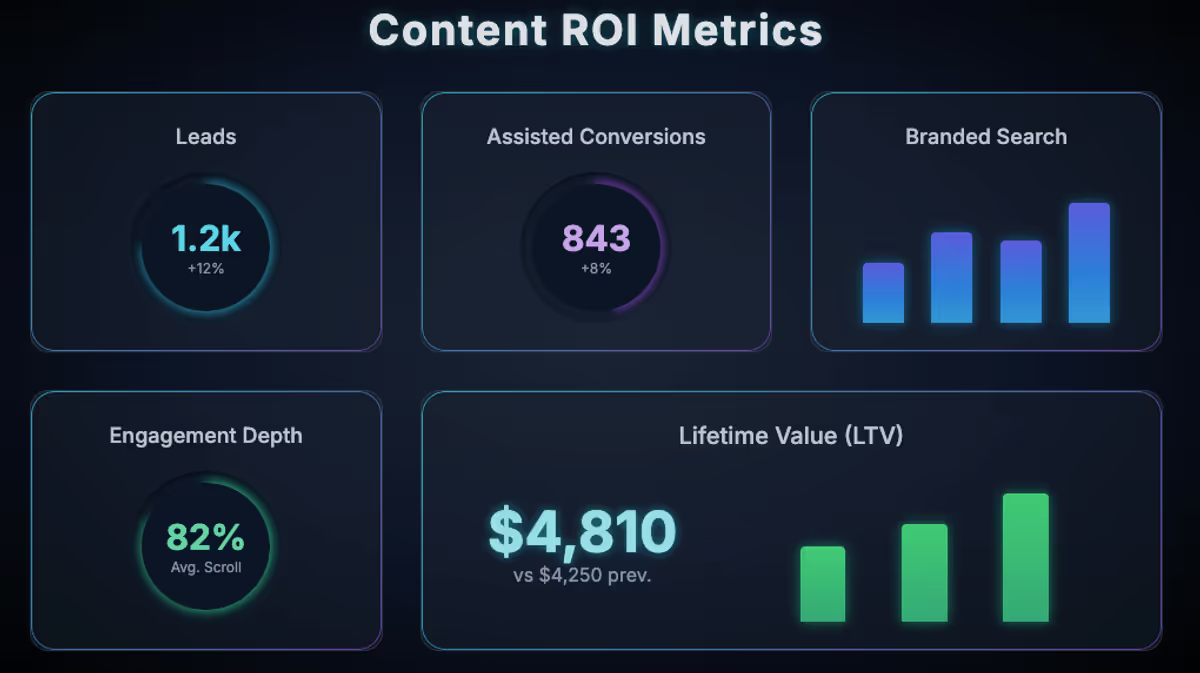Look, I'll be straight with you. When I saw Moz's recent piece asking "Should We Stop Creating Informational Content?", it got me thinking about how what we see in Google over the last 12 months and more has changed and how many businesses are struggling to adapt. The Moz team raises excellent points about the challenges we're all facing - zero-click searches, AI overviews, and the general squeeze on organic visibility.
And honestly? Their recommendations around tightening topical focus, adding genuine expertise, and thinking beyond traditional blog posts are spot on. But I think there's more to unpack here, especially when it comes to specific industries and practical implementation.
The reality is this: informational content isn't dead. It just evolved. And if you're still approaching it like it's 2019, then yeah, you're going to struggle. But for those of us willing to adapt and think strategically about content that serves real business goals, there's never been a better opportunity to leverage helpful content for genuine results.
Why This Content Evolution Matters Right Now
Let me start by acknowledging what we're all seeing. Google is absolutely sending fewer clicks for many informational queries. SparkToro's 2024 clickstream study shows that roughly 60% of searches now end without a click to the open web. That's a real challenge if your entire strategy revolves around getting people to your website.
But here's what I think deserves more attention - we're so focused on what Google is taking away that we're missing what they're actually showing us about what works in this new environment.
The search landscape in 2025 isn't just about zero-click SERPs. We've got branded search making up 45.7% of all Google searches according to Ahrefs, and younger users bypassing Google entirely for platforms like TikTok. eMarketer data shows 40% of Gen Z prefer TikTok for search.
So what does this mean in plain English? It means the old playbook of "create content for keywords and wait for traffic" is obsolete. But the opportunity to use informational content as a brand-building, lead-generating, authority-establishing tool? That's bigger than ever, you just need to approach it differently.
The Search As It Is in 2025: What's Really Happening
Let me paint you the picture of what search really looks like right now, because I think understanding the full picture helps us make better strategic decisions for long term gains.
Yes, zero-click searches are up. But what's interesting is how this creates opportunities for brands that understand the new game. When Google shows your content in featured snippets, knowledge panels, or AI overviews, that's valuable brand exposure that builds awareness and drives demand - even without the click.
The fact is, with search results as they are, we have to look at Google more as a brand marketing channel than how we used to look at it as a performance marketing channel.
The branded search surge is the real story here. When nearly half of all searches include a brand name, what does that tell you? It tells you that people are doing their research elsewhere - on social media, through content marketing, via word of mouth - and then coming to Google to find specific companies they already know about.
And Gen Z's move to TikTok search? That's not a problem to solve, it's a channel to embrace. The businesses winning right now are the ones creating search-optimized content across multiple platforms, not just Google.
Rethinking Informational Content: The Four Pillars
This is where I want to get practical, because theory doesn't pay the bills. After years of seeing what actually drives results, I've identified four pillars that separate informational content that works from content that just takes up server space.
Pillar 1: People-First, Not Keyword-First
I know, I know. Everyone says "people-first" these days because Google told us to. But most people are still doing keyword-first content with a people-first wrapper. Real people-first content starts with actual problems your audience faces, not search volume numbers.
When I was working with law firms, the ones that succeeded weren't the ones targeting "personal injury lawyer + city" with thin location pages. They were the ones answering the actual questions people ask after an accident: "Do I really need a lawyer for a fender bender?" "What if the other driver doesn't have insurance?" "How long do I have to file a claim for an injury in a car accident?"
Pillar 2: Brand-Building, Not Traffic-Chasing
Here's something that might sound counterintuitive: the best informational content often doesn't generate massive traffic. But it generates the right traffic, and more importantly, it builds brand recognition that pays dividends across all your marketing channels.
Think about it this way - would you rather have 10,000 anonymous visitors who bounce after 30 seconds, or 1,000 visitors who remember your brand name and search for you specifically six months later when they need your services?
Pillar 3: Omnichannel Distribution
Creating content for your blog and hoping people find it is like opening a store in the middle of nowhere and wondering why no one shows up. The content that works in 2025 is designed for multiple platforms from day one.
That comprehensive buyer's guide you created for your e-commerce site? Break it into TikTok videos, LinkedIn posts, email newsletter segments, and Instagram carousel posts. Each piece should link back to the full guide, creating multiple touchpoints with your audience.
This is not new advice either. Love him or hate him Gary Vaynerchuk has been urging people to repurpose content for years. Even back in 2019 before AI overviews were even a pipe dream for Google he mentions distributing your brands social media content. I'm not saying he saw this coming, but getting your content our there, in front of as many eyeballs and ears as possible is just good business sense.
Pillar 4: Multiformat Thinking
Text-only content is playing the game with one hand tied behind your back. The brands crushing it right now are thinking in terms of content ecosystems - how does this blog post become a video, an infographic, a podcast episode, and a downloadable PDF?
This isn't just about repurposing content. It's about understanding that different people consume information differently, and different formats serve different purposes in your funnel.
Now, lets take a look at how this folds into two different verticals which I know very well, Legal and ecommerce.
Vertical Deep-Dive: Legal Services
Let me get specific here, because I think legal services represent one of the biggest opportunities for informational content done right. The legal industry has some unique advantages that most sectors would kill for.
First, you've got hyper-local search behavior. Someone searching for "what to do after a car accident" isn't looking for generic advice - they need information specific to their state's laws, local procedures, and regional considerations. This gives local law firms a massive advantage over national directories and generic legal sites.
Second, E-E-A-T (Experience, Expertise, Authoritativeness, Trustworthiness) actually means something in legal. When you're a licensed attorney writing about legal topics in your jurisdiction, you have inherent authority that content farms can't replicate.
Here's what works: hyper-local FAQ content that addresses state-specific legal questions. Not "How to file for divorce" but "How to file for divorce in Florida: A step-by-step guide to Broward County procedures." Not "What is a statute of limitations" but "Statute of limitations for car accidents in Texas: What Dallas residents need to know."
The key is combining this local specificity with real value. Include downloadable checklists, link to actual state forms, provide templates people can use. Make your content so helpful that people bookmark it and share it with friends.
One case study that perfectly illustrates this approach is the Ghidotti case study showing how a successful content marketing campaign increased their clients revenue by over $1.8M . They didn't do this by creating generic legal content. They focused on highly specific, locally relevant guides that addressed real client concerns in their market.
For local law firms, here's what I recommend:
- Audit your top consultation questions and create state-specific FAQ content
- Develop case story pages with anonymized data and outcome metrics
- Create downloadable resources (checklists, timelines, forms) that capture leads
- Refresh your core practice area content annually with current laws and procedures
- Optimize your Google Business Profile like it's a social media account - because it basically is
Vertical Deep-Dive: E-Commerce
E-commerce presents a different but equally compelling opportunity for informational content. The key difference is that e-commerce content needs to serve the entire funnel, from initial research to final purchase decision.
Top-of-funnel content for e-commerce should focus on education and problem-solving. "How to choose the right hiking boots for your foot type" is infinitely more valuable than "Best hiking boots 2025" because it helps people understand what they actually need.
Middle-of-funnel content is where comparison guides and detailed buyer's guides shine. But here's where most brands go wrong - they create these massive, overwhelming guides that try to cover everything. The content that converts focuses on decision-making frameworks, not exhaustive product lists.
Bottom-of-funnel content includes detailed product information, user-generated content, and trust signals. This is where video demonstrations, customer photos, and detailed FAQ sections pay off.
Beardbrand's content strategy is a masterclass in this approach. They've created guides that rank for thousands of keywords and drive consistent growth, but more importantly, they've built a content ecosystem that educates their audience and builds brand loyalty throughout the customer journey.
For e-commerce stores, here's the playbook:
- Convert your best-selling categories into comprehensive buyer's guides with comparison tables and video demos
- Collect and display user-generated content on product pages
- Create product-finder quizzes that capture emails while providing value
- Develop video content for social platforms that links back to your guides
- Produce data-driven stories and infographics that earn backlinks and build authority
Rethinking the "More Content = Better Results" Approach
Here's where I want to challenge some conventional wisdom that I still see floating around the SEO community. There's this persistent belief that you need to build massive topic clusters and publish hundreds of pieces of content to "dominate" search results.
I think this approach misses the mark for most businesses. Unless you're in a position to out-resource and out-authority the current leaders in your space - which most small and medium businesses aren't - this strategy often delivers disappointing returns.
Here's what I've observed: a tightly focused content hub with high-quality, differentiated content consistently outperforms 30 thin articles. Quality over quantity isn't just a nice saying - it's a competitive advantage when everyone else is focused on hitting publishing quotas.
I'd rather see you create one comprehensive, annually updated guide that becomes the definitive resource in your niche than 20 surface-level blog posts that get lost in the noise. Quality over quantity isn't just a nice saying - it's a competitive advantage when everyone else is focused on hitting publishing quotas.
Map your content depth to actual conversion paths, not arbitrary topic maps you found in some SEO tool. What questions do people actually ask before they become customers? What information do they need to make a buying decision? Start there, not with keyword research.
An Action Plan To Get All This In Motion
Alright, enough theory. If you're convinced that informational content still has a place in your strategy, here's how to implement this approach:
For Service-Based Businesses (Legal, Medical, Financial, etc.):
- Audit your consultation intake process. What questions do prospects ask most frequently? Those are your content opportunities.
- Create location-specific resource hubs. Not thin location pages, but comprehensive guides that address local regulations, procedures, and considerations.
- Develop lead magnets that provide real value. Checklists, templates, and guides that people actually want to download.
- Establish your expertise with bylines and credentials. Make sure your content clearly establishes who you are and why people should trust your advice.
- Update and maintain your existing content. Outdated information kills trust faster than no information at all.
For E-Commerce Businesses:
- Start with your best-selling category and create the definitive buyer's guide. Include comparison tables, video demonstrations, and clear next steps.
- Implement a user-generated content strategy. Customer photos, reviews, and Q&A sections boost both conversion and long-tail rankings.
- Create interactive tools that capture leads. Product finders, size guides, and compatibility checkers provide value while building your email list.
- Develop a cross-platform content distribution strategy. Your blog content should fuel your social media, email marketing, and video content.
Invest in data-driven content that earns links. Industry reports, trend analyses, and original research that other sites want to reference.
You need to take the impetus here, most of the time these pieces of content are time specific and hoping they get found and picked up by publications is 99% of the time ineffective. You need to be proactive in getting these pieces of content in front of the eyeballs of those that matter.
Measuring Your Success Rather Than Pageviews
Here's where a lot of businesses get stuck in old thinking. If you're still measuring the success of your informational content primarily on pageviews and organic traffic, you're missing the bigger picture.
The metrics that actually matter:
- Lead generation: How many qualified leads does your content generate?
- Assisted conversions: How often does someone consume your content before making a purchase through another channel?
- Branded search growth: Are more people searching for your brand name after consuming your content?
- Engagement depth: Are people actually reading, sharing, and acting on your content?
- Customer lifetime value: Do customers who discover you through content have higher retention rates?
These metrics tell a much more complete story about the ROI of your content investment. And here's what I've seen consistently - businesses that track these metrics instead of just traffic tend to create much better content.
The Skinny On Informational Content's Evolution
Look, I get why some people are ready to throw in the towel on informational content. The landscape has changed dramatically, and the old strategies don't work anymore. But that doesn't mean the opportunity has disappeared - it means the opportunity has evolved.
The businesses that are winning with content in 2025 understand that informational content was never really about gaming Google's algorithm. It was always about building relationships, establishing authority, and being genuinely helpful to the people you serve.
Zero-click searches aren't the enemy - they're a new type of brand exposure. TikTok search isn't a threat - it's a new channel to master. AI overviews aren't stealing your traffic - they're highlighting your expertise to a broader audience.
The key is to stop thinking like an SEO trying to manipulate search results and start thinking like a business owner trying to build lasting relationships with customers. Create content that you'd be proud to put your name on. Solve real problems for real people. Be genuinely helpful, not just optimised for search engines.
Informational content isn't dead. It just grew up. And the businesses that grow up with it are going to dominate their markets for years to come.
The question isn't whether you should stop creating informational content. The question is whether you're ready to create informational content that actually works in 2025. If you are, the opportunity has never been bigger.


